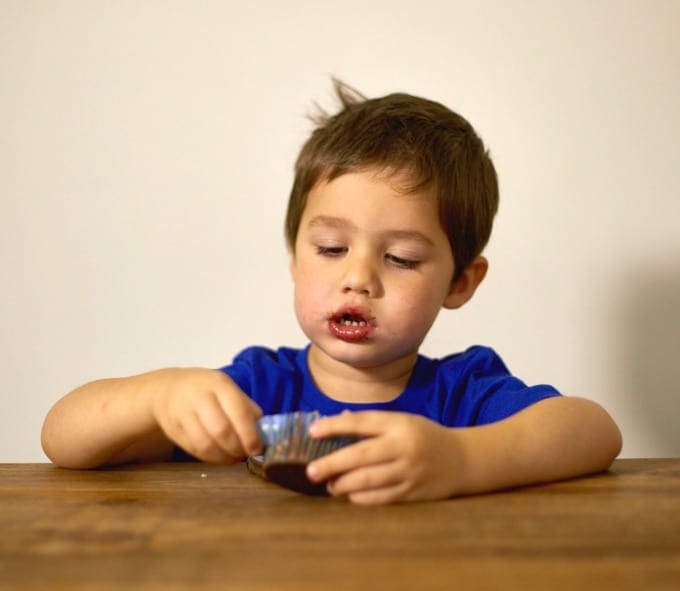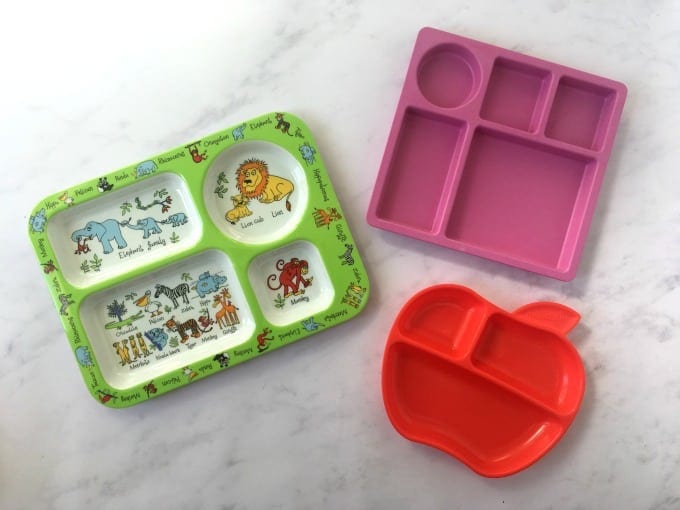This week is World Autism Awareness Week and for the next few days I’m going to devote some time on the blog to talking about autism and food and my experiences of both.
 image: Kim Lightbody Photography
image: Kim Lightbody Photography
This is Fintan, or Finn for short. Finn is four years old and he loves trains, playing at the park, watching Bing on tv and annoying egg surprise opening videos on You Tube. Finn is also autistic, diagnosed aged three and a half.
I’ve mentioned Finn and autism a little bit on my social media over the past year but not so much here on the blog. But with World Autism Awareness Week happening I thought this would be the perfect time to share our experiences of autism and it’s link with food and food issues.
Like many four year old’s, Finn is quite a picky eater but over the past year I have come to understand how autism plays a very big role in his food and feeding. Obviously my experiences are with my child only and every child will be different. But if by sharing my experience I can help one other family then I feel it will be worthwhile.
1. Sensory Reactions
I have to come to understand lately the extent to which sensory reactions play a very big part in the foods that Finn will and will not eat. Picky eaters in general, whether they are autistic or not, will have intense sensory reactions to food, based on texture, taste and smell. For many autistic children these sensory reactions are heightened which can lead to complete refusal of certain types of food.
Texture
Texture doesn’t seem to be a massive issue for Finn. He likes smooth textures such as yogurt but will also eat some foods with a lot of texture like granola. However a lot of children will have quite negative reactions to different textures and identifying these can be half the battle in tackling their food issues.
Taste
Taste wise Finn likes quite bland food without any strong flavour. For example he loves bread and breadsticks, pancakes, rice, Weetabix and fish fingers. Many autistic children will have the opposite preference and will actively seek out strong, spicy or sour flavours.
Temperature
Another sensory reaction Finn will have to food is temperature. He doesn’t like food to be hot, or even quite warm. He will push away even his favourite meals if they are too warm so we generally leave his food to cool before offering it to him.
Feel
The feel of food can also cause issues with feeding. I tend to think of this different than texture, as it’s simply in relation to how they react to the feel of food in their hands, as opposed to the texture when they eat it. Finn doesn’t like to get his hands messy and so when he eats finger foods they nearly always have to be dry.
By understanding Finn’s basic sensory reactions to food, we have been able to come up with a list of foods that we know he likes and will eat, and also use that knowledge to try to widen his choices.
For more advice on sensory sensitivity and picky eating, check out this really informative article by Jo Cormack.
2. Routine & Predictability
Most children, not just those with autism, thrive on routine and predictability. But for children on the spectrum, having a routine around food can be really important in helping them feel at ease at meal times when so many other things in their lives are unpredictable and chaotic.
Predictable but not reliant
For some children this means eating the same thing for breakfast, lunch or dinner every day. We obviously don’t want to encourage this but we can use this as a starting point to expand the range of foods that they eat.
Similarly we need to be careful when it comes to specific brands of foods. I have heard stories of autistic children becoming distraught when the packaging of their favourite foods have changed. This is obviously something completely out of our control as parents and so I try to limit foods where Finn has a strong association with the packaging or branding.
Predictability may also come in the crockery and cutlery that your child uses. Finn loves colourful or character plates. He especially enjoys these divided plates. They are fun and inviting but also separate out his food which I think he finds easier to cope with and makes it simple for me to add some new foods without causing too much stress.
 Plates from: Tyrrell Katz, Eats Amazing and Munchkin
Plates from: Tyrrell Katz, Eats Amazing and Munchkin
Small Changes
I always advocate very small changes when dealing with picky eaters and this is even more important for children with autism. Baby steps are needed when making changes to any area of their lives.
If for example your child eats cornflakes for breakfast every day, try adding just a very small portion of fruit in a separate bowl. Leave the bowl beside them but don’t force them to eat it. They may refuse that fruit every day for a week or two but eventually it will become part of their routine and they may pick up a piece and try it.
3. Stress & Anxiety
Autistic children will often feel high levels of stress and anxiety in many aspects of their lives but we can try as much as possible to remove this from food and feeding.
Freedom
One way we do this at home is to allow Finn to have a lot of freedom when it comes to mealtimes. We don’t force him to sit at the table. We give him a choice of sitting at the table, on a stool at the island or on the couch in the living room. This goes against advice you will often hear about sitting down as a family to eat, but if we forced Finn to sit somewhere where he was not comfortable, he would not eat.
We also allow Finn to watch tv or play on his tablet during mealtimes. Again this is contrary to a lot of advice other people will give but it means that he is relaxed and happy and will therefore eat more.
Choice
As Finn’s speech and general communication is improving I am also starting to offer him more choice when it comes to his food. This gives him an element of control over what he is eating which in turn reduces his stress at mealtimes.
Visuals can work really well for children with limited speech. PECS cards and visual timetables can allow a non-verbal children to choose foods and also prepares them for whats to come, which helps with predictability.

Autism and it’s related food issues is such a wide area and I feel like I have barely scratched the surface on this topic. I am obviously not a professional and my advice is based solely my own experience with Finn. If you are worried about your child’s eating and nutritional intake then you should of course seek help from your GP, paediatrician or autism health care professional.
I also appreciate that it is very much based on your own experience and your own child. So if you have any advice or tips you would like to share, please do leave them in the comments below, it would be great to get a conversation going.
Ciara xx






Anonymous says
Thank you for your suggestions. I’m desperate.! The next step is having to have a feeding tube surgically implanted in our four year old grandson. He will not eat anything of his own volition. I don’t think that most people actually understand that. I believe if left to himself, he would actually starve. I am so happy to have found your site where you understand the difficulty. I will try the divided trays for sure. The problem is though, that if I Vitamix the food and spoon feed him, he will eat it; but, his parents are adamant that he must feed himself. Surely getting the food in must come first and then work on his independence. I feel that, at least dinner, should be spoon fed to him, if that’s what it takes and then work on independence at breakfast and lunch.
Vicky says
Hi, That sounds like a really tough situation I’m sorry.But yes,I think a combination of spoon fed and working on independence would be good. Maybe spoon fed meals and independent snacks. I hope this is of some help to you, but please feel free to ask anymore questions if you have any. Please keep me updated on your progress. Ciara x
Crystal says
I’m a 43 year old adult with autism spectrum disorder. I wasn’t diagnosed until I was an adult. My diagnosis is autism spectrum disorder without cognitive delays type 1 which is a mouth full I prefer the old diagnostic system as I understand it better as to were I’m at. According to my therapist based on the old system (which isn’t used any more and is for my info only) I’d be pdd-nos I have all the sensory issues and stem (all be it discreetly using rocking chairs or pacing instead of classic rocking) like those with “classic” autism and have the cognitive and verbal skills typically associated with Aspergers. Doctors know now that people don’t fit neatly into those catergories and have done away with those labels but it helps me see were I’m at on the spectrum. Anyway I have alot of texture sensitivity as well as taste sensitivity and agree with what you said but it goes beyond that like for me I like sweet food and I like savory foods but they don’t go together EVER one example other people like that I won’t touch is sweet meat like honey roasted ham. Also a negitive texture can be covered by positive texture ( sometimes). Like I don’t like gummy/ chewy foods you won’t catch me eating gummy candy, beef jerky or unprossessed meats but I love creamy gooey foods like cream cheese, sour cream, regular cheeses, ranch, cream based soups ect and will occasionally tolerate unprossessed meat if it’s “tender” and it has enough gooey topping to “hide” the chewiness. The negative side of this is I’m very over weight from the high fat toppings I smother everything in.
Mejuju2 says
Hi ,I have a 16 year old that was diagnosed at 10 years old but has been and still is a picky eater. I don’t put his food in a plate. I sit all the food on the table and give him a choice of what he wants. (Buffet style if child is able of course!)And I have snuck cauliflower in mac and cheese pureed in the cheese sauce of course. I cook with olive and avocado oils. He will eat banana, and broccoli and cheese,tacos no tomatoes, any fish ,seafood besides clams, applesauce, white rice,mash potatoes or baked, sometimes vanilla icecream only vanilla cake no sprinkles!! I wish pizza and corndogs and lots of ketchup And he loves doritos blue bag only and any oreos. They will widen their food choice. I give still give him flinstones vitamins with iron, at first i use to put them in applesauce now he takes them willingly after watching the flintstones. I take him on the trails for a walk or bike ride so hes real hungry and it makes things easier for me like you want a sandwich he says i only eat peanut butter ones. I say were out want a Turkey sandwich I’ll put lettuce and abit of Italian dressing you like on it ok. He ate half Now he eats it every day for lunch. Homemade sugar cookies orange with carrot puree lol.
Moms,Dads Parents be creative and try to be patient it will happen. 7years ago i would have said yeah OK now I’m laughing. It does get better they will learn there routine and whats expected and you will see your hard work and effort pay off even if its a small step you will see some progress some more than others. So stay positive and persevere POAS (Parents Of Autistic Children)
Sarah says
Hi I’m a mum of two boys aged 4 and 2.
My 4 year old was diagnosed with Autism aged 3 and half.
We also have a daily battle with food, I have seen professionals and they can’t seem to help us and the response I have is that’s it all will take time which is very frustrating. My 4 year
Old will only eat dry things crackers and yoghurts he doesn’t eat any fruit or veg and and has iron deficiency
Soumia says
Hi dear !
Thank you for sharing your story !
My son is 5 years , he was diagnosed with autism since he was 2 years .
He is in Therpautic school for the summer too .
Next year he Still not fully potty trained and very picky since he was 2
He only eat cream cheese sandwich,
Chocolate chip cookies,chocolate milk cheese pizza , gold fish milk juice ,
He never eat any meat or veggies since he was 2 I’m worrying about his weight he becomes too light and skinny ,
Please gave me some ideas about t I’m waiting for his appointment with nutritionist.
Thank you so much !
Jean Nicol says
I came to a lot of the same conclusions about autism and picky eaters and think that for many the eating challenges are much more related to autism or SPD than to food itself. I created The Eating Game for an autistic boy addressing his needs related to control, structure, routine, predictability and the need for visual supports. Kids love it and it can very quickly become an independent activity planning healthy meals and snacks for the whole day.
David says
I think that nutrients are very important, cooking with extra virgin coconut oil, using fish oil, and astaxanthin, ll brain foods. Taking glycine as well. Vitamin D supplements seem to increase brain activity as well.
Lucy Thomas says
Hello Ciara such an informative blog! Just wanted to reach out and say Helloooo again (2yrs later) we met at an organix event. I’ve spent quite a lot of my private coaching helping children with Austism explore food. I’ve posted my chart on Instagram today let me know if you’d like the supporting material to use with Fintan can email it over xxx
Anna says
Hi Lucy. Is your insta public? Thanks